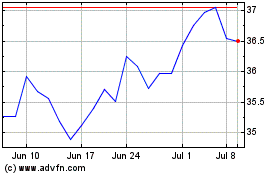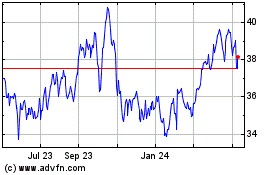BP: Oil Demand Is Going to Peak in the Next 20 Years -- Update
February 20 2018 - 11:40AM
Dow Jones News
By Christopher Alessi
LONDON--Global demand for crude oil could peak in the next two
decades, as renewables like solar power surge faster than expected
to meet a greater share of the world's energy needs, BP PLC said
Tuesday.
The world's appetite for oil and other liquid fuels could
continue to grow until around 2035, hitting 110.3 million barrels a
day--compared with 95 million barrels a day in 2015--before
plateauing and falling off in the run up to 2040, the British
oil-and-gas giant said Tuesday in the main future scenario,
releasing its annual energy outlook.
Peak demand could represent a potential reckoning for energy
companies that had grown accustomed to crude consumption growing
almost every year for over a century. Already, BP, Royal Dutch
Shell PLC and other companies have been investing more in natural
gas, which has become a vital fuel for producing electricity, and
experimenting with renewable production.
"The outlook here shows that the world is going to need all
forms of energy," BP Chief Executive Bob Dudley said at a news
conference Tuesday. "Gas has to be part of the transition, if not a
destination fuel" for lowering carbon emissions.
BP's outlook shows peak-oil demand coming more quickly than it
has forecast in the past. Until now, the company has said crude
demand wouldn't stop growing until the 2040s.
Unlike competitors, BP releases annual forecasts making
predictions about a range of issues including industry investment,
supply and demand. Shell has said peak demand could come as soon as
2025 while Chevron Corp. and Exxon Mobil Corp. don't foresee a
peak.
BP's central forecast assumes that current government policies,
technology and societal preferences will evolve in the future
similarly to how they have in recent years. Big recent changes have
included countries like the U.K. and France planning severe
restrictions on the combustion engine and a major push for electric
vehicles in China.
BP stressed the central forecast was one of six possible
scenarios, none of which it would endorse as most likely. All the
scenarios show oil demand eventually peaking before 2040 and then
declining.
In this scenario, renewable sources of energy would increase
five-fold to provide around 14% of primary energy globally,
contributing to the most diversified energy mix ever.
"By 2040, oil, gas, coal and non-fossil fuels each account for
around a quarter of the world's energy. More than 40% of the
overall increase in energy demand is met by renewable energy," said
Spencer Dale, BP's group chief economist.
Oil consumption should grow by an average of 0.14% per year
between 2016 and 2040, according to the BP scenario, compared with
predictions of 0.19%, 0.12% and 0.17% annual oil growth consumption
by, respectively, the U.S. Energy Information Administration, the
International Energy Agency and the Organization of the Petroleum
Exporting Countries.
Still, BP expects personal vehicles and industrial trucks "to be
dominated by oil," with demand for the fuel comprising around 85%
of total transport fuel demand in 2040, compared with 94% today.
The majority of that demand should come from developing economies
like China and India, BP said.
At the same time, BP's evolving transition scenario predicts the
number of electric cars on the road will rise to roughly 320
million by 2040, accounting for about 30% of passenger vehicle
kilometers. That increase should be bolstered by the emergence of
fully-autonomous vehicles in the next decade, most of which are
expected to be electrically powered.
BP's views on peak-oil demand aren't universally accepted in the
industry. Last month at the World Economic Forum in Davos,
Switzerland, Saudi energy minister Khalid al-Falih said oil demand
would rise as high as 120 million barrels a day over the next two
to three decades.
Write to Christopher Alessi at christopher.alessi@wsj.com
(END) Dow Jones Newswires
February 20, 2018 11:25 ET (16:25 GMT)
Copyright (c) 2018 Dow Jones & Company, Inc.
BP (NYSE:BP)
Historical Stock Chart
From Mar 2024 to Apr 2024

BP (NYSE:BP)
Historical Stock Chart
From Apr 2023 to Apr 2024
